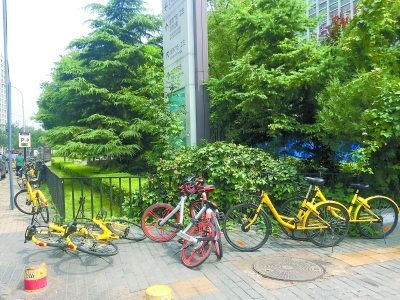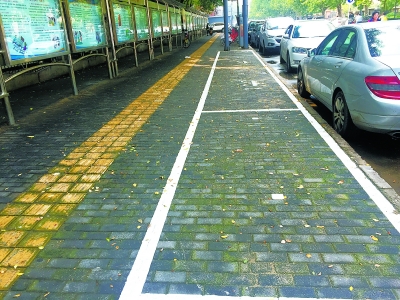It is difficult to find the location without navigation prompts, and the shared bicycle cannot be seen in the electronic fence

Yesterday, on Xingfu Village Middle Road near Sanlitun, the electronic fence was empty (see picture below), while many shared bicycles were parked crooked around Shimao Square a few dozen meters away (see picture above). Photo by Sun Hongyang

Since the beginning of this year, Tongzhou, Chaoyang, Dongcheng and other districts of the city have piloted the establishment of electronic fences for shared bicycles, hoping to circle the shared bicycles parked indiscriminately. However, the reporter visited more than ten electronic fences in the city yesterday and found that due to the lack of prompts and rewards for parking inside and outside the fences, some fences are set up in a relatively biased position. There is not a single shared bicycle in many electronic fences, and there are still a large number of bicycles parked indiscriminately near the fence. Why has this much-watched "black technology" for shared bicycle management received such a cold reception?
It’s not easy to find an electric fence.
In order for users to park their cars in the electronic fence, they must first be able to find the "fence". However, the reporter’s experience found that unless they happened to meet during the ride, it was not easy to find the electronic fence through the APP.
Yesterday, the reporter rode the ofo small yellow cart to the vicinity of Tongzhou Wanda Plaza. From the APP map, you can see several electronic fences marked with a blue P character around, the nearest of which is near Xinhua South 1st Street. But the reporter cycled around, but never found the parking area marked with a white line on the roadside. Careful inspection found that an open space marked "temporary bicycle parking place" was the closest to the blue P character position. There were only a few electric vehicles parked sporadically in the open space, but there was still no clearly marked electronic fence area.
Ms. Hu, a citizen who lives in Tongzhou, told reporters that although she often sees parking areas marked with the blue P word on the ofo Small Yellow Cart APP, she usually gives up looking for standardized parking areas because she cannot navigate the electronic fence. "Can you be like Autonavi and Baidu maps, and automatically prompt’there is a parking area nearby ‘during riding and automatically navigate?" Ms. Hu suggested.
The reporter’s experience found that ofo’s small yellow cart, Mobike bicycle and other shared bicycles are currently unable to navigate the electronic fence. From the appearance, except for the public electronic fence near Chaoyang Sanlitun and the electronic fence in Chongwenmen area, which can see sensing devices on the ground, most electronic fences are no different from ordinary non-motor vehicle parking areas.
Parking without rewards and punishments is not binding
At this stage of the pilot of electronic fences in many regions of the city, companies such as ofo yellow cart and Mobike said that from the perspective of cultivating user habits, a transition process from points encouragement to punishment is needed. However, the reporter’s experience found that even points encouragement has not been realized at present.
Reporters have been in Tongzhou’s Beiyuan subway station, Beigong University Tongzhou campus, Zhishan Home, Chaoyang Sanlitun near, Dongcheng Chongwenmen area test, first shared bicycles parked in the electronic fence, and then parked a few meters away from the fence, the mobile phone client side did not receive any points reward or "park outside the specified area" prompt. Ofo small yellow car customer service staff told reporters that at present, it is only recommended that users park in the electronic fence and marking parking area, not mandatory, that is to say, parking inside and outside the fence has no impact on users.
"Indeed, the management of shared bicycles with electronic fences is still the management thinking of public rental bicycles with piles." An industry insider who has been engaged in the management of public rental bicycles for many years told reporters that if the government department does not force companies to punish users who do not enter the fence, I am afraid that no company will be willing to "take the lead in self-discipline", because that would mean losing the innate advantage of dockless parking.
At the end of last month, the relevant person in charge of the Software Service Department of the Municipal Economic and Information Commission introduced that Tongzhou will soon launch a shared bicycle electronic fence system with potential penalties. For illegal parking, whether to directly fine money or take a continuous billing method, the relevant parties are still accelerating negotiations with enterprises.
Why don’t you set up points where there is a lot of parking?
Why is there no car in the electronic fence, but a lot of cars are parked on the roadside dozens of meters away? This strange phenomenon cannot be attributed to users’ unconsciousness. The reporter observed that this is not unrelated to the location of the electronic fence.
Yesterday at noon, the reporter saw four electronic fences near Tongzhou Zhishan Home, Beigong University Tongzhou Branch, and Tongzhou Conference Center. There was not a single shared bicycle in the fence, and there were no cyclists parking at these locations. Some nearby shops and restaurants did not have parking areas in front of them, but there were different brands of shared bicycles parked in stitches. And riding around Tongzhou Wanda Plaza, which has a large traffic flow, I couldn’t find an electronic fence for parking shared bicycles, and many non-motorized vehicles were parked messily on the non-segregated belt. Similarly, on Xingfu Village Middle Road near Sanlitun, the public electronic fence was also empty, while around Shimao Plaza, dozens of meters away, there were many shared bicycles parked crooked, and some even lying on the side of the road.
Why can’t the electronic fence be marked on the "knot"? Can’t it be marked on the most popular areas where random parking is the most serious? Zhang Jianbo, the person in charge of the public electronic fence project for shared bicycles, told reporters that when the government plans the parking area, in addition to considering the flow of people, it must also ensure that there is enough wide walkway space for pedestrians. For example, around Sanlitun, three of the dozen electronic fence points initially reported failed to pass. "Although these points have parking needs, they are places that should not be parked." Zhang Jianbo said.
Road planning is a global consideration, while cyclists vote with their feet. Therefore, there is a lot of indiscriminate parking where you should not park, and no one stops where there is a fence.
Electronic fences are not the ultimate solution
The number of electronic fences and parking areas is far from keeping up with the scale of deployment. The reporter saw in the interview that once the electronic fence is filled with shared bicycles, the operators will expand their territory beyond the white line.
"Electronic fencing is not the ultimate solution for the management of shared bicycle parking." Zhang Jianbo told reporters that if the total amount is not controlled from the source, any management method will lag behind. He believes that it is impossible for citizens’ short-distance travel to be exhausted in a way of shared bicycles, and there will inevitably be some people who rely on public transportation to divert traffic, which is scientific and efficient. It is understood that Shijingshan has already made total control of shared bicycle delivery, and enterprises need to submit to the government for approval if they exceed the amount of investment.
Li Junhui, a special researcher at the Intellectual Property Research Center of China University of Political Science and Law, said that shared bicycles have been in the market for some time, and enterprises can fully grasp the number of bicycles at various points through big data platforms, but obviously offline management is relatively lagging behind, and operation and maintenance capabilities should be strengthened. Li Junhui believes that shared bicycle parking occupies public space, and it is inevitable that resources will be wasted in the operation and maintenance of each enterprise platform. It may be possible to form a joint force through division of labor, cooperation and unified deployment.